#Mediterranean climate plants
Photo

check out my shop here!
#olive tree#trees#olives#olive branch#peace#pretty#mediterranean#climate#photo#photography#art#artists on tumblr#artists of tumblr#plants#leaves#botanical#garden#grow#trendy#aesthetic#redbubble
4 notes
·
View notes
Text
Landscape in San Francisco
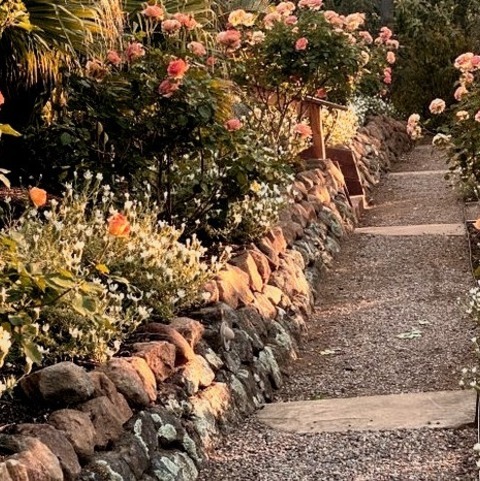
Here is an illustration of a sizable, full-sun, Mediterranean-style gravel flower bed in the summer.
#mediterranean climat landscape#landscape#roses and palms#south african plants in a mediterranean climate landscape#los altos hills
0 notes
Photo
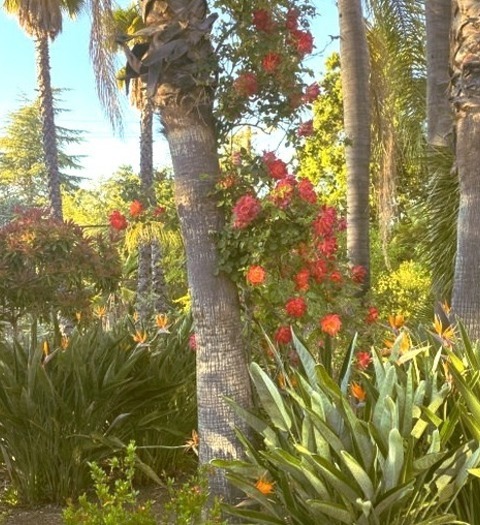
Landscape Desert Look in San Francisco
Inspiration for a large mediterranean drought-tolerant, desert and full sun courtyard decomposed granite landscaping in summer.
#los altos hills#mediterranean climat landscape#roses and palms#south african plants in a mediterranean climate landscape#landscape
0 notes
Text
So, this is cool:
We need to convince more municipalities to plant more trees. I would suggest looking into trees that are more heat and drought tolerant (oaks, not western red cedar, for an example) & also those that grow more quickly. Planting on the west and south (or north, if you're in the Southern hemisphere) of a building matters the most for heat reduction.
If you want to get into it, I'd suggest finding your Köppen climate classification, and then finding either native trees that can thrive in a hotter-but-otherwise-similar climate than yours, or trees from such a climate. For example, I'm in a warm-summer Mediterranean climate so I'm looking at plants from Hot-summer Mediterranean climates that are hardy enough to still survive our winters (oaks, I'm looking at oaks. Fortunately, one species extends from here to down there, so that's easy).
I wouldn't usually advocate for non-native plants, but I'm seeing the climate change quickly enough that I think maybe humans should help with the pole-wards migration of plants.
2K notes
·
View notes
Text

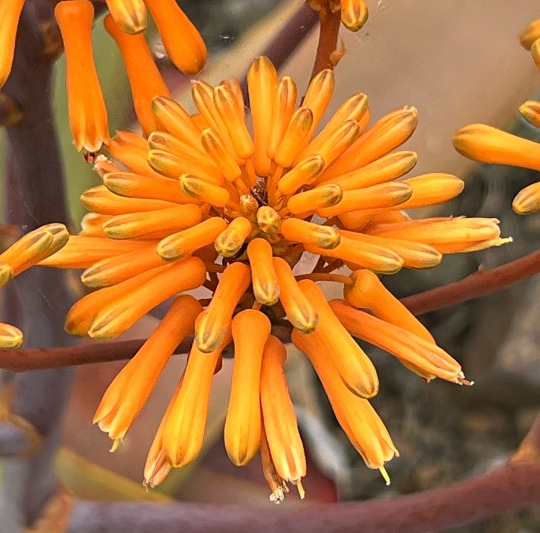
Aloe buhrii (orange)
This Aloe species belongs to a group whose best known member is Aloe striata. However, Aloe buhrii is a much rarer plant in nature and comes from farther to the northwest in the winter-rainfall region. This makes it an ideal choice for Mediterranean-climate gardens, and it is an excellent spring bloomer in our part of California. Its flowers come in yellow or orange - the orange form is pictured here.
-Brian
66 notes
·
View notes
Note
What would be the main differences between a template forest and a tropical jungle for fantasy? I guess that things like iron armor pieces would never become a thing since historically they weren't popular in other hot climates, winters without snow might be less feared but summers with big floods might be more worrisome? I guess that cuisine and farming would also be massively different although I don't know exactly how.
Out of the top of my head:
Equatorial climates are notoriously stable, since it's always the same day lenght there are no seasons, especially if you live near the ocean which estabilizes the temperature. You will get dry and wet seasons (and sometimes even hurricane seasons) depending on particular geographic conditions
Tropical/subtropical climates often have harsher seasons the farther away from the ocean they are, but never snow (that's the difference actually; temperate climates can get snow, subtropical can get frost but not snow, tropical neither). So yes, in general in a tropical or subtropical the main difference between seasons is rain, and perhaps frost which does play a role in some plants like citrics. Rainforests, of course, get it all year, subtropical forests have dry and rainy seasons. You can see a mixture of both: in my home (Northern Argentina) we do get marked winters with ocassional frost, but the main fact is that they're dry compared to summer.
ANYWAYS. Cultural stuff! Yes, one of the main differences you will find is clothing. It's difficult to make generalizations, but overall, tropical cultures just wear less, if there is armor at all. Don't get mistaken and say that it's because they don't have metallurgy, though, it's just that metal armor is indeed heavy, hot, and not much use if the opponet isn't wearing anything either. At most, you would see padded cloth armor (cotton mostly) or hide/leather at most. If you look at soldiers from, for example, Mesoamerica or Southeast Asia, you will find little armor.
Similarily, while you can go wild with noble clothing and colors, and the preferred materials are indeed cotton or silk, you will find very simple clothes among the general population. To give you an idea, here's a sample of Aztec clothes (including armor!)

Note how simple and lightweight they are, even for rulers. They are colorful too (the artist, Daniel Parada, has more pictures like this for other cultures based on historical records) but although tropical enviroments might seem to have greater access to dyes, medieval european did also have dyes, often not as vibrant as carmine though.
Farming, of course, affects cuisine. I think that instead of thinking about a "pan-tropical" farming, we could analyze this by centers of origin of crops:
From Southeast Asia we got soy, several types of beans (or Fabaceae if you wanna get technical), all citrics, mango, banana, pear, cherry,, but this pales in comparison to rice, of course. Rice defines the tropical and subtropical diet of Asia, being what wheat is to the Mediterranean. Rice cultivation is particular in that is labor extensive, much more productive by area compared to other crops (so smaller plots) and requires extensive irrigation, resulting in complex managed enviroments.
From tropical America we got manioc, squashes (all sorts of curcubita actually), beans, peppers, pineapples, papaya, so much more, but it's especifically from Mesoamerica we got corn, and from the Andes we got potatoes. Potatoes are key in cold climates. Meanwhile, the corn-beans-squash trio, that is known in North America as "three sisters" and in Latin America as "milpa" is spread all over the continent. These three kinds of plants are very adaptable to tropical and subtropical conditions, and combined are very productive.
I will admit that my knowledge about tropical Africa is less than ideal. There are native species of rice that can be found in Western Africa, Ethiopia has traditionally grown barley and sorghum (and is the home of coffee), and millet, like corn for the Americas, seem to be widespread.
As for spices, tropical areas do seem to be blessed with spices, this is true. I recommend this guy to tell you about it. Hell, I recommend his channel in general.
What IS a common theme, regardless, is that jungles are NOT pristine enviroments or wild enviroments untouched by human activity. Jungles have been managed, in overt ways (like for example, rice cultivation) or more subtle ways (planting domesticated species inside the forest) for thousands of years. This is also done by controlled burns, conscious planting, or even accidental things, like, for example, peoples settling in a place and bringing domesticated plants to that place that then grow semi-wildly.
THIS IS SO FRUSTRATING TO TALK ABOUT BECAUSE EVEN IF I STUDY THIS EXACT THING, I HAVE NO REAL DEFINITION OF IT YOU CAN SEARCH. You can find about this phenomenon of "humans managing and changing forest enviroments" by lots of terms, like agroforestry, silviculture, and so many more. The term I use is "landscape management" (no, not "landscaping") where a "landscape" is a term for an enviroment were both humans and natural factors build it (like I said, there is no thing as "pristine nature" ALL natural enviroments have been managed and modified by humans, and you can find evidence of that in tropical America, Asia, and Africa).
In fact, the reason why those enviroments seem "natural" and unchanged to Western views is precisely, because tropical cultures often use wood and adobe to build structures (if they have them at all), which don'r preserve well at all. But also, jungles are fast growing and often eat everything, remaining, interestingly, these subtle domestication and managment efforts in what once were thriving settlements.
Which doesn't mean you haven't tropical cultures to study. THERE ARE PLENTY. You got, like I said, the whole of tropical America, tropical Africa, and tropical Asia and Oceania. It is getting very difficult to me to generalize, and yet, one can see some similarities.
Since this post is general enough, I encourage you to ask more about what you want. What would you like me to focus on?
oh, and you can throw me a tip, if you want! Sorry for selling out, but I'm living under an insane libertarian president right now, so every bit helps!
#worldbuilding#sorry this is such a rant#but I hope it might be useful for you to get questions I can answer better!
81 notes
·
View notes
Text
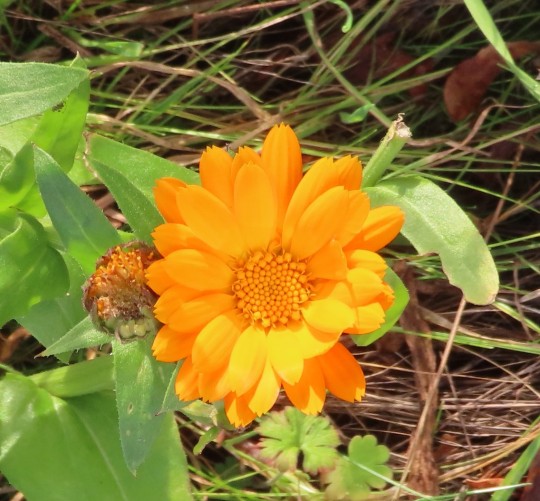

Calendula arvensis (field marigold)
Welcome to January! There may be nothing going on in my flowerbeds but down by the railway tracks, the weeds are doing just fine. This European wildflower, the field marigold, now has worldwide distribution and they seem to like the climate in Vancouver - a lot.
After three unusually sunny, dry summers we're now in the middle of an El Nino winter (read: unusually mild). Under ideal conditions, this Mediterranean plant can bloom year-round. Apparently, these are ideal conditions. Not that I'm complaining. I just love those dayglo orange petals.
#flowers#photographers on tumblr#field marigold#orange#January#fleurs#flores#fiori#blumen#bloemen#Vancouver
116 notes
·
View notes
Text
Herbalism 101: Lavender

Fun Fact: Lavender is a part of the mint family; making it a natural insect repellent.
English lavender (Lavandula angustifolia) is an excellent way to add a mid-summer pop of color to your garden or patio. Planting is somewhere where you can enjoy its beautiful scent. English lavender is more tolerant of colder temperatures common in the Marquette area than French lavender, making it an excellent choice for herb gardens and perennial borders. This is a member of the mint family features aromatic leaves and flowers that are popular for cooking purposes, medicinal use, and home projects.
Lavender is prized as a culinary ingredient. Lemon and lavender make a great combination for baking cookies, cakes, and other delicacies. Lavender can also be used to infuse simple syrups for cocktails or lemonades.
Lavender’s lovely scent is known to reduce anxiety and calm the mind. The calming fragrance of a lavender plant is thought to provide relief from stress, depression, and migraines. It is also considered anti-inflammatory and has antiseptic properties.
Lavender attracts beneficial pollinators to its flowers. Adding lavender to your garden will attract butterflies, bees, and other helpful insects.
Lavender plants are deer resistant. Making them a welcome addition for many homeowners looking for plants they don’t have to share with the local wildlife.
Lavender from your garden can be dried and used to create items such as homemade lavender soap, bath salts, potpourri, sachets, and cleaning products.
Lavender does well in most climates. The plant is drought resistant and will form a large swath of flowering plants. The blue flowers are not only beautiful but smell fabulous. You can harvest the blooms through the summer and prune the plant back in the fall.
-flower works blog
Lavender is a flowering plant in the mint family that’s easily identified by its sweet floral scent. It’s believed to be native to the Mediterranean, The Middle East, and India, with a history dating as far back as 2,500 years.
According to everyday health blog, Possible health benefits of Lavender include:
May help improve sleep.
Can help treat skein blemishes.
May offer a natural remedy for pain.
Reduce blood pressure and heart rate.
Could relieve asthma symptoms.
Help combat fungus growth.
Potentially promotes hair growth.
Helps relieve stress.
Lavender hasn’t been approved by the FDA, so it’s important to be aware of potential health risks or side effects of using this herb.
📷© Pinterest
#witch#kitchen witch#pagan#witch blog#herbs#witchcraft#kitchen witchery#green witch#hearth witch#herbal magick#witchy#pagan witch#witch aesthetic#witches#witchyvibes#baby witch#cottage witch#earth witch#forest witch#hedge witch#kitchen witchcraft#lunar witch#nature witch#witch community#witch core#witch familiars#witch history#witch tips#witchblr#witchcore
334 notes
·
View notes
Text
Sage
Salvia officinalis
Known as: Common sage, green sage, garden sage, meadow sage, culinary sage & true sage
Related plants: A member of the of the mint family Lamiaceae that includes plants such as basil, mint, rosemary, sage, savory, marjoram, oregano, hyssop, thyme, lavender & perilla as well as catnip, salvia, bee balm, wild dagga & oriental motherwort.
Parts used: Leaves & stems
Habitat and cultivation: This evergreen subshrub is native to the Mediterranean region with it's mild to cool, rainy winters & warm to hot, dry summers.
Plant type: Perennial
Region: Zone 5-8 your sage will grow as a hardy perennial. However in the humid climates of zones 9 & farther south, sage is usually an annual, as it does not easily tolerate summer heat & humidity.
Harvest: Harvest lightly in the first year to ensure the plant grows fully. After the first year, be sure to leave a few stalks so that the plant can rejuvenate in the future & If fully established, one plant can be harvested up to three times in one season.
Planting tips: Plant in full sun & plants should be two feet apart. Sage should be planted in well draining soil like a sandy or loamy soil with good drainage. Wet soils can cause rot and be fatal to the plant. The easiest and best way to start sage is from a small plant, but you can also sow seeds up to two weeks before the last frost date.
Medicinal information: Taking sage by mouth seems to improve memory and thinking skills in healthy adults & taking it for four weeks can improve menopause symptoms. One study found that drinking tea made from sage both raised antioxidant defenses and lowered LDL or “bad” cholesterol. It also could be used for pain after surgery, lung cancer, sore throat, sunburn, and many other conditions. Sage leaves have been used in traditional medicine as a treatment for diabetes.
Cautions: Sage is possibly unsafe when taken in high doses or for a long time due to a chemical called thujone. Too much thujone can cause seizures and damage the liver and nervous system. Thujone can also bring on a menstrual period, which could cause a miscarriage so taking sage during pregnancy is not advised. It may also reduce milk production while chest feeding.
Magickal properties
Gender: Masculine
Planet: Jupiter
Element: Air
Deities: Chiron, Consus, Jupiter, Obatala & Zeus
Magickal uses:
• Use the leaves for tea for communion of Jupiter or in any workings involved with the planet & grounding
• Burn to find clarity & wisdom while asking difficult questions
• Write a wish on Sage leaf and burn it to release your intention
• Place a Sage leaf in your wallet to attract money
• Include in feminine fertility spells to boost your chances of success
• Add Sage oil incense or herbs to any spell to temper the results with wisdom
• Burn during a funeral & memorial to facilitate healthy grief and bonding with the spirits of those who passed on
• Use spells to alleviate grief & steady emotions
• Put in a satchet to carry from protection from negative energies & influences
• Burn to cleanse your home, clear negative energies & increase your intuition
• Rub sage on your forehead before divination to increase the accuracy of your results
• Pick twelve leaves at midnight on Christmas Eve to see a vision of your future husband(without damaging the bush)
• Write your desire on a sage leafe & place it under your pillow for three days. If you dream of your desire, it will soon materialize. If not, bury the sage.

#herb of the week#sage#herbalism#green sage#witchblr#wiccablr#paganblr#witch tumblr#witches of tumblr#witch community#witchcraft#book of shadows#grimoire#spellbook#spells#spellcraft#green witchery#green witch#magical herbs#beginner witch#baby witch#witch tips#baby witch tips#beginner witch tips#witch#spellwork#witchy things#GreenWitchcrafts#correspondence#witchcore
132 notes
·
View notes
Text
An “unheard of” marine heatwave off the coasts of the UK and Ireland poses a serious threat to species, scientists have warned.
Sea temperatures, particularly off the north-east coast of England and the west of Ireland, are several degrees above normal, smashing records for late spring and early summer. The North Sea and north Atlantic are experiencing higher temperatures, data shows.
Daniela Schmidt, a professor of earth sciences at the University of Bristol, said: “The extreme and unprecedented temperatures show the power of the combination of human-induced warming and natural climate variability like El Niño."
“While marine heatwaves are found in warmer seas like the Mediterranean, such anomalous temperatures in this part of the north Atlantic are unheard of. They have been linked to less dust from the Sahara but also the North Atlantic climate variability, which will need further understanding to unravel."
“Heat, like on land, stresses marine organisms. In other parts of the world, we have seen several mass mortalities of marine plants and animals caused by ocean heatwave which have caused hundreds of millions of pounds of losses, in fisheries income, carbon storage, cultural values and habitat loss. As long as we are not dramatically cutting emissions, these heatwaves will continue to destroy our ecosystems. But as this is happening below the surface of the ocean, it will go unnoticed.”
168 notes
·
View notes
Text

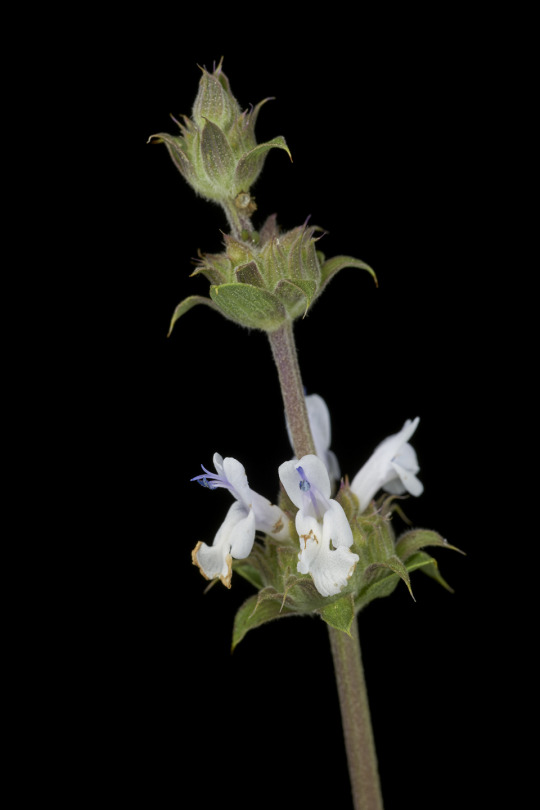
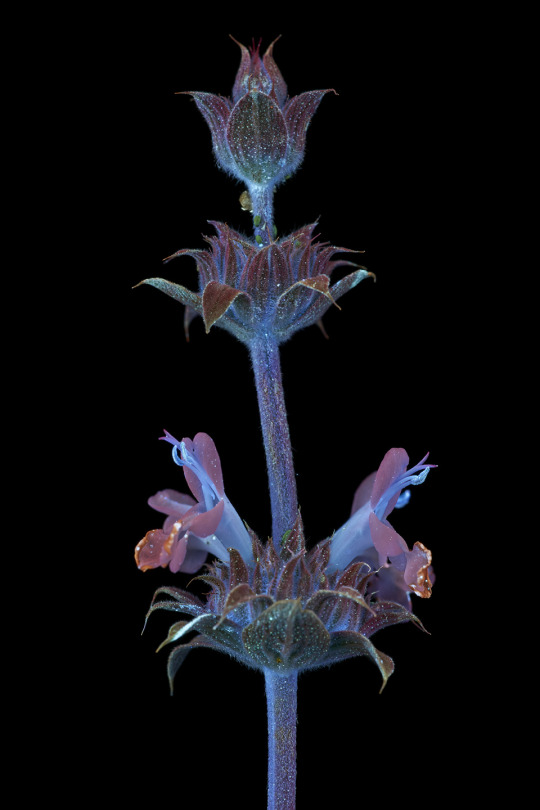
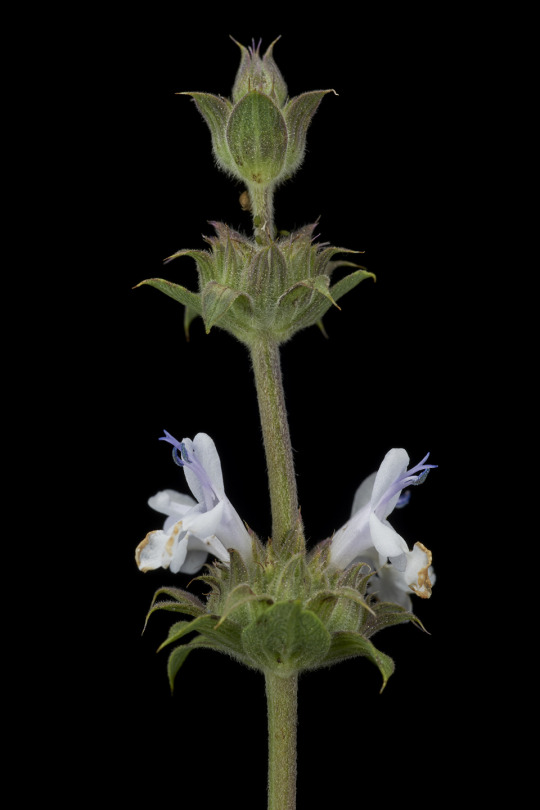

Salvia mellifera, black sage, is a perennial shrub in the mint/sage family native from central California down through the top of Baja California. It is part of the cast of plants present in coastal sage and chaparral habitat, thriving only in a specific range of rainfall in a mediterranean climate. The flowers host a variety of pollinators including butterflies, hummingbirds, and native bees and its seeds, like other Salvia species, are abundant and provide food for animals and birds. The fragrant leaves contain chemicals used by the Chumash to treat pain and a unique spicy honey is derived from the plant in the modern day.
108 notes
·
View notes
Text
A writer’s guide to forests: from the poles to the tropics, part 6
Welcome back. We’re getting closer to the equator. Things are really heating up now.(…I’ll see myself out now)
Mediterranean forest
Here is where the line between myth and reality begin to blur, and history reveals itself.
Location- The region around the Mediterranean Sea, bordered by the Alps and the deserts of the Middle East and Northern Africa. Much of the forest area has been altered by human activity, with the largest expanse remaining located in the Iberian peninsula.
Climate- Warm and dry. Mountains are more reliably wet, with higher elevations being seasonal.
Plant life- Trees are evergreen at or near sea level, with cork oak and olive common. Atlas cedar grow in Morocco, and the Levant is home to Cedar of Lebanon. In Alpine regions, deciduous species such as Hornbeam, lime, and elm eventually give way to pines as one goes higher. Dry areas produce many hardy species of ground cover, including the unusual dewy pine (Drosophyllum lusitanicum)- this is the only perennial carnivorous plant that does not grow in a wetland or humid environment.
Animal life- Due to millennia of human activity, predators, such as lions, wolves, bears, and lions have mostly or totally vanished. The largest hunter one may stumble across is the Iberian Lynx, though this is unlikely. Extinction has also affected prey species, with the Pyrenees ibex going extinct twice (the second time occurred after a clone ibex died shortly after birth). Conservation efforts have meant that species from eagles to dormice have a chance to recover. North Africa and Gibraltar are home to Barbary Macaques. Where humans manage forestland, herds of goats and pigs forage.
How the forest affects the story- Unless you want your characters high in the mountains, you don’t have to worry too much about the seasons( granted, winters can still be cold, but trees are evergreen and the summer heat will be the biggest worry) As these forests have been cleared and managed since the Neolithic, it is your choice as to where your characters fit into the grand picture. Do your characters and their society harvest the forest or graze their livestock there? Or maybe your characters have decided to restore the forest. What would restoration efforts look like? And of course, history and prehistory can provide a backdrop and various peoples to interact with. Could your characters have crossed paths with Otzi the iceman? What about the Romans, pilgrims, crusaders, Phoneticians, or Celtic-Iberians? And you don’t have to limit yourself to history. This is the land of the Greek Myths, and countless others as well. Gods, heros, and monsters may lurk behind the trees and in the caves.
#writing#creative writing#writing guide#writing inspiration#writing prompts#writers#writer on tumblr#writeblr#writing community
49 notes
·
View notes
Photo

Lara Aloe Plant
Aloe plants are believed to have originated in the Arabian Peninsula and spread to other parts of the world, including North Africa, the Mediterranean region, and various parts of the world where the climate is warm and dry.
The leaves of a decorative aloe plant can come in a range of colors, including shades of green, gray, blue, and red.
Aloe plants bring a sense of resilience, strength, and unpredictability to a space. This wild element can be visually interesting and can help create a more organic atmosphere in a room.
You can choose if you want the plant in a vase or without.
Game-ready low poly, optimized for low-end computers. Base game compatible.
Set includes:
Aloe Plant | Aloe Flower | Pot | Aloe Plant + Pot
Download: NynaeveDesign.com
#sims#thesims#thesims4#sims4cc#custom content#3D design#decor#plants#houseplants#pot#planter#vase#flower#aloe#succulent#NynaeveDesign
136 notes
·
View notes
Text
THAT FUCKING REMINDS ME, I have a headcanon about Mathias (hws Denmark) and it's specifically that he was a small child during the Migration Period and got to witness the volcanic winter of 536 AD, otherwise known as 'the worst year to be alive.'
So in late 535/spring 536 AD, we know there was a massive volcanic eruption somewhere, and another eruption in 539/540 AD in what is today Lake Ilopango, El Salvador (and possibly a third eruption in 547 AD, investigations still ongoing); both of these eruptions were each "of unprecedented magnitude," and that they occurred in such quick succession massively impacted the climate worldwide, causing calamities like famines, drought etc. They also actively blocked out the sun.
The effects were devastating, as the ejecta and sulphur dioxide aerosols reached the lower stratosphere and began to circle the globe. The sun’s light was blocked in a hazy mist that allowed no heat to penetrate, while at night the heavens were filled with wavering curtains of fiery colour, like a sunset that went on for months (Edvard Munch’s famous painting The Scream shows such skies, then a result of the Krakatau eruption). Scientists refer to this phenomenon as the ‘dust veil’.
The impact was not unlike that of a nuclear winter. Trees began to wither, their growth stunted, as seen in the dendrochronological record. Unseasonal cold gripped the northern hemisphere, with snow in the summer months visible in the Norwegian high-altitude data. The weakened sunlight most directly affected plant life of all kinds, including crops, quite literally taking out the food supply. Written sources from China and India describe harvest problems and disrupted weather patterns; the environmental evidence is consistent from North America to mainland Europe. In the Mediterranean world, writers among the Goths and other militarised imperial successors described the famine, riots, and slide into civil unrest that resulted from the failed harvests in the endless winter.
Northern areas were hit particularly hard, and both volcanologists and archeologists estimate Scandinavia's population loss to be as much as 50%. That is catastrophic. That's multiple entire towns outright disappearing. It was so catastrophic, that the ancient northern Germanic cultures changed from having a sun-based religion/worship to making up stories about giant wolves eating the sun at the end of the world. These eruptions were so catastrophic that we got Norse mythology out of them. Just look at the Prose Edda, talking about the lead-up to Ragnarok:
First of all that a winter will come called Fimbulwinter (lit. 'Mighty winter').
Then snow will drift from all directions.
There will then be great frosts and keen winds.
The sun will do no good.
There will be three of these winters together
and no summer between.
Now that's some generational trauma right there. (Ftr the Finns have something similar in the Kalevala.)
Okay, so taking HWS Denmark as a character:
(canon) considers himself to be the oldest brother of the Nordics and their leader, and that it's his job to look after them
(headcanon) would've been a small child when he experienced one of the Earth's worst climate events
(canon) was at least alive during the Viking Age, and as a viking was very much part of the Old Norse culture
Old Norse mythology and cultural values were heavily impacted by the 536-540 AD volcanic eruptions, particularly the strong sense of community (because you will not survive the winter if you're alone) and the general hall culture/shelter vs hostile nature trope (because, like before, not having shelter will kill you).
So, my headcanon is that Mathias witnessed the literal sun go dark for several years, leading to a horrific death toll among his people to the point where he came up with a new religion based on it and was part of a culture that transformed to highly value in-group/out-group mentality to the point of basing their morality on it, and affecting him pretty much the rest of his life as even as an adult he considers it his job to take care of his 'in-group,' in this case the other Nordics. Thanks for coming to my Ted Talk.
tldr: multiple volcanic eruptions during the Migration Period caused the sun to disappear for a little while and it fucked up Mathias forever.
(quotes are from Neil Price's book Children of Ash and Elm: A History of the Vikings)
#historical hetalia#hetalia#hetalia headcanons#hetalia hcs#hetalia hc#hetalia headcanon#hws denmark#aph denmark
20 notes
·
View notes
Text
🌿Rosemary Devotional - Day 3: Cultivation, Foraging and Preparation.
Cultivation.
Since it is attractive and drought-tolerant, rosemary is used as an ornamental plant in gardens especially in regions of Mediterranean climate where it is considered easy to grow and pest-resistant.
Rosemary prefers sandy, well-draining soil, which is necessary for its health, but even then it is hard to germinate and slow growing. It thrives in maritime conditions. but is usually frost tender. In colder climates, grow it in containers and move indoors to overwinter. Prune it often to promote healthy growth.
Rosemary can grow quite large and retain attractiveness for many years, can be pruned into formal shapes and low hedges, and has been used for topiary.
Foraging and Preparation.
Harvest twigs to use fresh or hang them and air dry, then store in an airtight container to preserve the aroma. Gather no more than a third of the shrub at the time, allowing plant to regrow before net harvest. As the aroma and flavour come from volatile oils, fresh rosemary is preferred in all cases; it loses the potency in time.

Sources: Herbalist's Primer by Anna Urbanek : iNaturalist
#🌿 Plant Spirit Devotion#🌿 Rosemary Devotional#herbal magick#plant spirit#plant ally#herbal ally#paganism#pagan#paganblr#green witch#witchcraft#witchblr
25 notes
·
View notes
Text
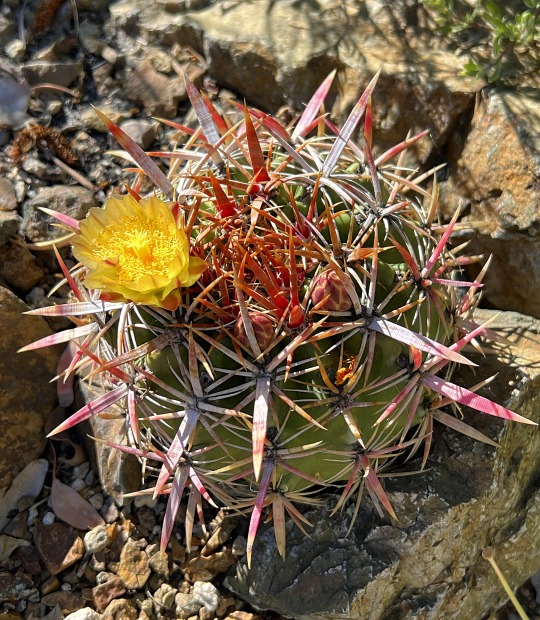
Ferocactus viridescens
There are not very many cacti native to areas with a Mediterranean climate (with dry summers and a winter rainy season), but this is just such a species, native to the San Diego area in southern California and southward into northwestern Baja California. Plants in Ferocactus are often referred to as barrel cacti, but this one is too small to make one think of a barrel. The name "viridescens" refers the the greenish flowers often seen with the species, though this is not much in evidence with the plant pictured.
-Brian
45 notes
·
View notes